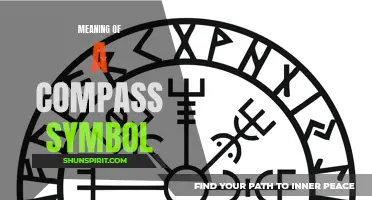
The Aztec civilization, known for its stunning art and advanced understanding of astronomy, left behind a fascinating legacy in the form of their intricate calendar. This calendar, comprised of various symbols that represented different aspects of life, continues to captivate modern-day historians, artists, and scholars alike. Through decoding these symbols and understanding their meanings, we gain a deeper understanding of the Aztec civilization's rich culture, complex belief systems, and unique perception of time. Join us on a journey into the world of the Aztec calendar symbols and discover the intriguing stories they hold.
What You'll Learn
- What are some common symbols found on the Aztec calendar and what do they represent?
- How did the Aztecs use their calendar symbols in their daily lives and rituals?
- Are there any particular meanings or interpretations associated with specific days or months on the Aztec calendar?
- How does the Aztec calendar differ from other Mesoamerican calendars, such as the Maya calendar?
- How have modern scholars decoded and interpreted the symbols and meanings of the Aztec calendar?

What are some common symbols found on the Aztec calendar and what do they represent?
The Aztec calendar is a fascinating and intricate system that was used by the ancient Aztec civilization in Mexico. This calendar, also known as the "Sun Stone," is a round stone tablet that contains a number of symbols representing different aspects of the Aztec culture and their understanding of time and space. In this article, we will explore some of the most common symbols found on the Aztec calendar and what they represent.
One of the central symbols on the Aztec calendar is the face of the sun god Tonatiuh. Tonatiuh is depicted as a fierce and powerful deity with a face composed of jaguar features and a tongue sticking out. This symbolizes the sun's ability to bring forth life, but also its destructive power. The sun was of great importance to the Aztecs, who believed that human sacrifices were necessary to ensure the continued rising of the sun each day.
Another significant symbol on the Aztec calendar is the feathered serpent, represented by the god Quetzalcoatl. The feathered serpent symbolizes a number of concepts, including wisdom, fertility, and the duality of life and death. Quetzalcoatl was a central deity in the Aztec pantheon and was associated with knowledge, creation, and the arts.
The Aztec calendar also includes various animal symbols, with each representing different aspects of the natural world. For example, the eagle represents the sun and is associated with the god Huitzilopochtli, who was the Aztec god of war and the sun. The eagle was believed to carry souls to the sun, making it an important symbol of death and the afterlife.
The jaguar, another common symbol on the Aztec calendar, is associated with power, strength, and the earth. In Aztec mythology, the jaguar was considered a powerful and mystical creature, capable of transforming into human form. It was believed to have a close connection to the spiritual realm.
Other symbols found on the Aztec calendar include various celestial bodies, such as the moon and the stars. The moon symbolizes femininity and fertility, and is associated with the goddess Coyolxauhqui, who was the moon goddess in Aztec mythology. The stars are associated with the afterlife and were believed to guide the souls of the deceased to their final resting place.
Overall, the symbols found on the Aztec calendar represent a complex understanding of time, space, and the natural world. Each symbol has its own unique meaning and significance within the Aztec culture. The calendar's intricate design and wealth of symbols reflect the intricate and sophisticated understanding of the world held by the ancient Aztec civilization.
Unlocking the Meaning: Understanding Enlightenment Buddhist Symbols and Their Significance
You may want to see also

How did the Aztecs use their calendar symbols in their daily lives and rituals?
The Aztecs were highly advanced and had a complex understanding of time. Their calendar system was an integral part of their daily lives and rituals. The calendar was not just a way of organizing time; it was deeply intertwined with their religious beliefs and practices. The Aztecs believed that time was cyclical and that each day had its own significance and meaning.
The Aztec calendar was divided into several cycles, with the most important being the Tonalpohualli, which consisted of 260 days. Each day in this cycle was represented by a combination of a number and a symbol. The symbols were derived from their natural environment and were associated with various gods and deities.
For example, the day sign of "Eagle" represented the sun god Huitzilopochtli, while the day sign of "Jaguar" represented the god Tezcatlipoca. These symbols were not only used to represent specific days but also had broader meanings and associations. They were seen as divine forces that influenced human destiny and determined the outcome of different events.
In their daily lives, the Aztecs would consult the calendar to determine the most auspicious days for important activities such as planting crops, going to war, or conducting religious ceremonies. They believed that by aligning themselves with the energy of the day, they could ensure success and avoid any negative influences.
The calendar also played a crucial role in the Aztec religious ceremonies. They would hold elaborate rituals to honor the gods and seek their favor. The day sign and number of the day would determine which god or deity they would worship and which offerings and sacrifices were required. By performing the rituals on the appropriate day, the Aztecs believed they could maintain harmony with the gods and ensure the continued prosperity of their society.
Furthermore, the calendar symbols were also depicted in Aztec art and architecture. They would carve the symbols into stone sculptures, pottery, and other art forms. These depictions would serve as reminders of the gods and their influence on daily life. They would also adorn their temples and ceremonial centers with symbols and sculptures to create a sacred space in which to connect with the divine.
Overall, the Aztecs used their calendar symbols in their daily lives and rituals to establish a connection with their gods and maintain harmony with the natural world. The symbols were not just representations of time but were considered powerful forces that shaped human destiny. By aligning themselves with the energy of the day, the Aztecs believed they could ensure success and prosperity in all aspects of their lives.
Uncovering the Enigmatic Meanings Behind Supernatural Symbols
You may want to see also

Are there any particular meanings or interpretations associated with specific days or months on the Aztec calendar?
The Aztec calendar is a historical system of tracking and counting time that was used by the ancient Aztec civilization in what is now modern-day Mexico. The calendar consisted of two separate cycles: the tonalpohualli, which was a 260-day ritual cycle, and the xiuhpohualli, which was a 365-day solar calendar. Each of these cycles had its own unique significance and meanings associated with specific days and months.
In the tonalpohualli, each day was represented by a combination of a number (from 1 to 13) and a specific name or glyph. These names were associated with various natural elements, such as animals, plants, and celestial bodies. For example, the first day of the tonalpohualli was called "Cipactli," which means "crocodile" in the Nahuatl language. It was believed that each day had its own unique energy or spiritual quality, and people would consult the tonalpohualli to determine the most auspicious times for various activities.
Similarly, the xiuhpohualli had 18 months of 20 days each, plus a short five-day period known as the "nemontemi." Each month in the xiuhpohualli was associated with a specific deity or natural element, reflecting the Aztec's deep connection to the natural world. Some examples of the month names include "Tlacaxipehualiztli," which means "flaying of men" and was associated with the god Xipe Totec and the spring equinox, and "Panquetzaliztli," which means "raising of banners" and was associated with the god Huitzilopochtli and the winter solstice.
These specific days and months on the Aztec calendar held great cultural and religious significance for the Aztec people. They used the calendar system to plan agricultural activities, religious ceremonies, and other important events. The calendar was also deeply intertwined with the Aztec mythology and cosmology, as each day and month was believed to be influenced by specific gods and celestial forces.
While the Aztec calendar is no longer in use today, it remains an important aspect of Aztec cultural heritage. It serves as a reminder of the rich spiritual and cultural traditions of the Aztec civilization and continues to fascinate researchers and enthusiasts alike. The meanings and interpretations associated with specific days and months on the Aztec calendar provide valuable insights into the Aztec worldview and their relationship with the natural and divine realms.
Understanding the Symbols on a Multimeter: A Guide for Beginners
You may want to see also

How does the Aztec calendar differ from other Mesoamerican calendars, such as the Maya calendar?
The Aztec calendar, also known as the Mexica calendar, was a system of timekeeping used by the Aztecs, a Mesoamerican civilization that flourished from the 14th to the 16th centuries. While it shares some similarities with other Mesoamerican calendars, such as the Maya calendar, the Aztec calendar also has some unique features that set it apart.
One major difference between the Aztec calendar and the Maya calendar is the way they track time. The Maya calendar is a complex system that incorporates multiple cycles, including the Tzolk'in, which is based on a 260-day cycle, and the Haab', which is a 365-day solar year. These cycles are combined to create a Long Count system that allows the Maya to track dates over long periods of time.
In contrast, the Aztec calendar is based on a simpler system that focuses on cycles of 52 years, known as the Xiuhmolpilli. This 52-year cycle was considered to be a "bundle of years" and marked a significant period of time in Aztec society. At the end of each 52-year cycle, the Aztecs believed that the world was in danger of ending, and they conducted various rituals and ceremonies to prevent this from happening.
Another key difference between the Aztec and Maya calendars is the way they represent time. The Maya calendar uses a combination of hieroglyphs and numbers to represent dates, while the Aztec calendar is primarily pictorial in nature. The Aztec calendar, known as the Sun Stone or the Stone of the Five Suns, is a large circular stone monument that features detailed carvings depicting various gods, symbols, and astronomical features. This stone serves as a visual representation of the Aztec calendar and is considered a significant work of art.
In terms of the underlying calculations, both the Aztec and Maya calendars were based on a 365-day solar year, similar to the modern Gregorian calendar. However, the Aztec calendar did not account for the extra fraction of a day in the solar year, whereas the Maya calendar implemented a more accurate method of tracking the solar year.
Despite these differences, both the Aztec and Maya calendars played a crucial role in the respective civilizations' religious and cultural practices. They were used for determining important dates for religious ceremonies, agricultural activities, and the governance of their societies. The calendars were also used for astrological purposes, as the Mesoamericans believed that the movements of celestial bodies influenced human affairs.
In conclusion, while the Aztec and Maya calendars share some similarities in terms of their purpose and function, the Aztec calendar differed in its focus on the 52-year cycle and its pictorial representation. These unique features have contributed to the Aztec calendar's recognition as an important cultural artifact and a symbol of the Aztec civilization's sophisticated understanding of time.
Exploring the Profound Meaning Behind Sacred Geometry Symbols
You may want to see also

How have modern scholars decoded and interpreted the symbols and meanings of the Aztec calendar?
The Aztec calendar is one of the most fascinating and enigmatic creations of the ancient world. Its intricate symbols and meanings have puzzled scholars for centuries, but through a combination of careful analysis and historical knowledge, modern scholars have been able to decode and interpret its secrets.
The Aztec calendar, also known as the "Sun Stone," is a massive circular stone carving that measures over 11 feet in diameter and weighs around 24 tons. It was created by the Aztecs, a powerful civilization that flourished in what is now Mexico from the 14th to the 16th centuries. The calendar served as a way to track time and was also used to make predictions about the future.
At first glance, the Aztec calendar appears to be nothing more than a jumble of symbols and hieroglyphs. However, scholars have discovered that each symbol has a specific meaning and represents a different cosmic force or element. For example, the central image on the calendar is a face-like sun with an extended tongue, which represents the sun god Tonatiuh. The surrounding symbols depict various animals, plants, and other celestial bodies.
Decoding the meaning of these symbols was no easy task. Scholars had to rely on a combination of archaeological evidence, historical accounts, and linguistic analysis to unravel the mysteries of the Aztec calendar. They studied similar Mesoamerican calendars and compared the symbols and meanings, looking for patterns and similarities.
One method scholars used to decode the calendar was to consult surviving Aztec codices, which are ancient manuscripts that contain information about Aztec religious beliefs and practices. These codices provided valuable insights into the meaning of certain symbols and helped scholars understand how the calendar was used in religious ceremonies and rituals.
Another important source of information was the Spanish conquest of the Aztec Empire in the 16th century. The Spanish invaders documented their encounters with the Aztecs and recorded important details about their culture and traditions. These historical accounts provided crucial context for understanding the symbols and meanings of the Aztec calendar.
Through their research, scholars have discovered that the Aztec calendar is a complex system that tracks multiple cycles of time simultaneously. The calendar consists of two interlocking wheels, with one representing the solar year and the other representing the sacred 260-day calendar. By combining these two wheels, the Aztecs were able to create a highly accurate calendar that accounted for both solar and ceremonial events.
In addition to tracking time, the Aztec calendar was also used to make predictions and prophecies. Scholars have identified certain symbols and combinations of symbols that were believed to be omens for the future. For example, certain patterns of stars and planets were thought to indicate the likelihood of a good harvest or a devastating drought.
Overall, modern scholars have made significant progress in decoding and interpreting the symbols and meanings of the Aztec calendar. Through a combination of careful analysis, archaeological evidence, historical accounts, and linguistic analysis, they have been able to unravel the mysteries of this ancient artifact. Although some aspects of the calendar remain unclear, our understanding of its symbols and meanings continues to grow, providing valuable insights into the rich and complex culture of the Aztec civilization.
The Symbolic Meaning of the Sun and Moon: Exploring the Depths of Light and Darkness
You may want to see also
Frequently asked questions
The Aztec calendar symbols hold great significance in Aztec culture as they represent various aspects of their cosmology and belief system. Each symbol corresponds to a specific deity, natural element, or cosmic event, allowing the Aztecs to interpret and understand the world around them.
The Aztec calendar symbols were utilized in several ways. One of the most well-known is the Aztec calendar stone, also known as the Sun Stone. This massive stone disc contains a complex arrangement of symbols that represent different time periods, celestial bodies, and deities. Additionally, the calendar symbols were used in Aztec artwork, architecture, and even in the design of everyday objects such as pottery and jewelry.
Some common Aztec calendar symbols and their meanings include the sun symbol, which represents Tonatiuh, the Aztec sun god; the feathered serpent symbol, which represents Quetzalcoatl, one of the most important deities in Aztec mythology; and the jaguar symbol, which represents Tezcatlipoca, the god of the night sky and sorcery.
While the Aztec civilization may no longer exist, the meanings attributed to their calendar symbols still hold cultural and historical relevance today. Many people continue to study and interpret the symbols to gain insight into Aztec spirituality and worldview. Additionally, the symbolism of certain Aztec calendar symbols, such as the sun symbol, continues to be used in modern-day Mexican and Mesoamerican art and culture.







